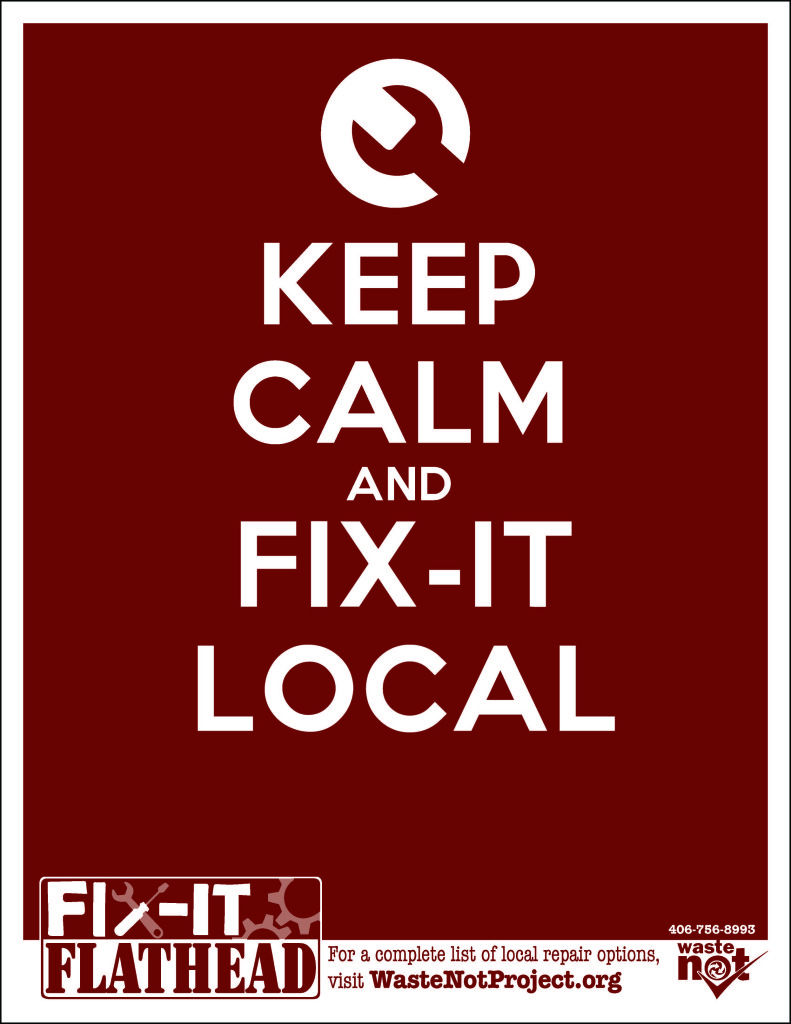Download a copy of our Fix It Local brochure for a complete list of local repair options! Our guide features over 50 local repair businesses for all sorts of household items.
We’re always looking for ways to improve our guide. Have something you want repaired, but it’s not listed? Know a repair person who’s not named? Send us your comments, ideas and suggestions!
Learn more about repair:
The 4th R
Repair Tips
REPAIR: The 4th R
If it is broke, fix it!
It’s often easier to trash broken appliances, electronics, or furniture and buy new ones, rather than trying to fix them. And while recycling our appliances and electronics is better than trashing, these products are often “down-cycled”, meaning the recycled product is less valuable than the original material. Plus we’re still consuming raw materials in purchasing a new product, adding to our environmental footprint.
Why is it easier to trash our old stuff? Repair used to be common practice, but has gone out of style in the last 50 years thanks to a concept known as “planned obsolescence”. Planned obsolescence is a strategy used by manufacturers to ensure future sales. Items are designed to last only a certain amount of time before they break and you have to buy a new one.
Furthermore, products have become difficult to disassemble and replacement parts more expensive to discourage repair. Products are “designed for the dump” in order to spur more spending and more consumption.
Bringing back repair completes the missing link in reducing our waste. Repair has many benefits, including:
- Repair saves resources. Making things last longer is both more efficient and more cost effective than mining for raw materials.
- Repair saves you money. Fixing things is usually cheaper than replacing them. Doing the repair yourself saves even more money.
- Repair supports local businesses and creates skilled jobs.
- Repair connects us to our things. Investing time and energy into repair adds value that transcends consumerism.
We can join the repair revolution to fight planned obsolescence and take back ownership of our stuff.
Some tips to get you started:
Shop Smart!
- Before you buy, research online customer reviews to check the quality of the product.
- Look for long-term warranties. Register for the warranty if needed, and keep it along with the sales receipt in a safe place.
- Avoid products that do not allow you to open the back or replace a part, or products made with flimsy materials.
- Extend the life of your purchases with routine cleaning and maintenance.
Do It Yourself
- DIY repair has never been easier! There are tons of online guides to help you with all sorts of household repairs. Find a list of repair website in our guide.
- Order specialized or hard-to-find parts online.
- Check the manual or manufacturer’s website for tips.
- Search for video tutorials on YouTube.
- If you’re not internet savvy, borrow a repair book from the library.
Keep Professional Repairs Affordable
- Use the warranty if you have one.
- Ask friends and coworkers to recommend a repair shop.
- Get an accurate quote by describing the issue in detail to the repair person. Ask how long the product should last after repair. Compare this with the cost and lifespan of a new model to determine if repair is cost effective.
Fix It Online Repair Guides
- www.ifixit.com
Comprehensive online community with guides, tools, and parts. - www.partselect.com
Replacement parts and repair guides for appliances, lawn equipment, and electronics. - www.appliancerepair.net
Guides for repairing most appliances. - www.bicycletutor.com/guide
How to guides for bicycle repairs. - www.repairsuniverse.com
Repair guides and replacement parts for mobile devices. - www.gearaid.com/blogs/learn
Repair instructions and maintenance products for outdoor gear. - www.water-heater-repair-guide.com
Guide for identifying and diagnosing issues with water heaters. - www.fixitclub.com
Online resources for repair projects of all kinds. - www.murfelectricbikes.com
A guide to bike maintenance and upkeep. - www.allfreesewing.com
Free patterns and tutorials for sewing projects and common alterations. - www.repairclinic.com
Parts and guides for repairing household items.




